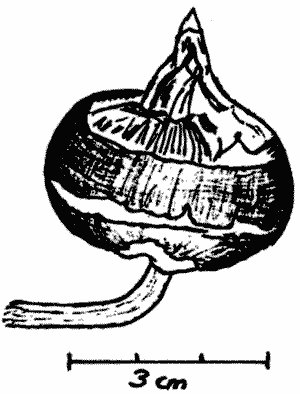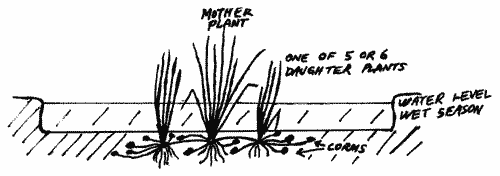
CHINESE WATER CHESTNUT
SCIENTIFIC NAME: Eleocharis dulcis
FAMILY: Cyperaceae
 |  |
| Mature corm of good size | Plant's growth habit |
Further to the article on Chinese Water Chestnut in our last newsletter, No.57 by Dallis Rayner, I thought my experience in North Queensland with this crop might be of interest.
After tasting some canned Chinese Water Chestnuts many years ago, I can remember thinking that cornflakes packets didn't taste all that bad after all. I guess my experience was similar to the canned lychee story.
These chestnuts were native to Australia, and as the swamp behind our place is full of reeds of Eleocharis spp., (leading me to hope that they would grow well here), I decided to get some seed pieces and see what real Chinese Water Chestnuts tasted like. At a cost of around $2 each seed piece, I decided not to eat any of the ones I bought from Dallis but to plant them and let them multiply (with luck).
With a back-hoe, we had a bed approximately 30m x 5m, dug near the swamp. The idea was to let the wet season fill the bed and when it dried, we would dig up the nuts. The seeds arrived but the rain didn't. After weeks of trying we finally got the pond to hold water; the water was soaking out as fast as it was pumped in. It appears now that this filling and draining may have helped the plants. The seeds were planted approximately 1m apart in three rows. They were planted as sprouted corms in mid September. By mid-October, half those planted were about 200mm high, the rest had died.
Parent Chinese Water Chestnuts plants produce 5 or 6 underground rhizomes. These form other plants and at a later time, they all produce more rhizomes that result in the annual nut crop. My parent plants produced their daughter plants in late November. Nuts were there to harvest in July but the water level was still about 200mm deep. It is August now and we are still digging nuts - when we get time.
At this stage we appear to harvest around ½ kg of nuts from each parent plant (each seed planted that grew).
Some of the things we will try this coming season are:
- Planting at closer intervals 30cm x 60cm.
- Planting the corms in pots and planting them out as plants.
- Regular applications of a complete fertilizer as our soil is very poor.
- Some applications of old mill mud to help retain water in the pond.
- More efficient weed control around the edges of the pond.
This last 12 months, we saw small green grasshoppers cause considerable damage to the reeds and mole crickets cause considerable damage to the underground corms only after the water had drained and the soil become dry.
We have found the nuts to be very palatable, even just freshly-dug and washed without peeling. I consider them to be a useful home vegetable with some possible market value.
DATE: September 1989
* * * * * * * * * * * * *
